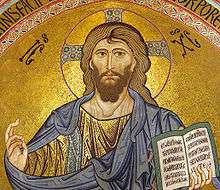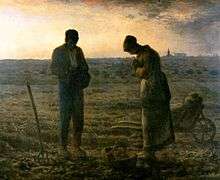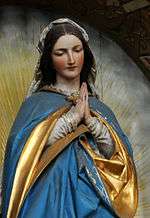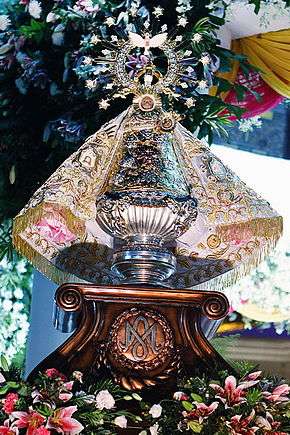Catholic devotions
Catholic devotions are particular customs, rituals, and practices of worship of God or honour of the saints which are in addition to the liturgy of the Catholic Church. The United States Conference of Catholic Bishops describes devotions as "expressions of love and fidelity that arise from the intersection of one's own faith, culture and the Gospel of Jesus Christ".[1] Devotions are not considered part of liturgical worship, even if they are performed in a church or led by a priest,[2] but rather they are paraliturgical. The Congregation for Divine Worship at the Vatican publishes a Directory on Popular Piety and the Liturgy.[3]
Catholic devotions have various forms, ranging from formalized, multi-day prayers such as novenas[4] to activities which do not involve any prayers, such as Eucharistic adoration outside Mass,[5] the wearing of scapulars,[6] the veneration of the saints, the Canonical coronations of sacred Marian or Christological images and even horticultural practices such as maintaining a Mary garden.[4]
Common examples of Catholic devotions include the Rosary, the Stations of the Cross, the Sacred Heart of Jesus, the Holy Face of Jesus, the various scapulars, the Immaculate Heart of Mary, Our Lady of Guadalupe, Seven Sorrows of Mary, novenas to various saints, pilgrimages, devotions to the Blessed Sacrament, and the veneration of saintly images.
Background
While the Catholic Church considers liturgy to be central to the life and mission of the Church, it acknowledges the benefit of popular devotions, stating in Sacrosanctum Concilium that "The spiritual life, however, is not limited solely to participation in the liturgy... Popular devotions of the Christian people are to be highly commended, provided they accord with the laws and norms of the Church, above all when they are ordered by the Apostolic See... These devotions should be so drawn up that they harmonize with the liturgical seasons, accord with the sacred liturgy, are in some fashion derived from it, and lead the people to it, since, in fact, the liturgy by its very nature far surpasses any of them."[7]
Several factors shape the efficacy of devotional practices in eliciting feelings of devotion: a strong emotional appeal, a simplicity of form which puts them within the reach of all, the association with many others engaged in the same practices, and their derivation from the example of others considered to lead a holy life.[6]
Since the Middle Ages, popes have encouraged devotions such as Eucharistic Adoration, the Rosary and the Stations of the Cross, while maintaining the primacy of liturgy over private devotions.[8] Pious devotions have influenced some important parts of the Catholic calendar such as the feast of Corpus Christi which arose after petitions by those following the devotion; or various Marian feasts that gradually appeared with the growth of devotions.[9] Catholic devotions can form the basis of major community events, such as the statue of our Our Lady of Zapopan, which attracts over one million pilgrims on October 12 each year as the statue travels through the streets moving from one cathedral to another.[10][11]
In Catholic tradition, a wide range of practices have developed, ranging from devotions to the Holy Trinity to specific saints. The three-level hierarchy of latria, hyperdulia and dulia determines the appropriate type of worship or veneration for different situations.[12][13] Latria (from the Greek λατρεία, latreia) is used for worship, adoration and reverence directed only to the Holy Trinity.[14] Dulia (from the Greek δουλεία, douleia) is the kind of honor given to the communion of saints, while the Blessed Virgin Mary is honored with hyperdulia, a higher form of dulia but lower than latria.[12][13]
Various unapproved acts such as the promotion of chain letters that contain prayers or the belief that the use of a statue of Saint Joseph can speed up the sale of a house have been discouraged as non-pious, superstitious and against Catholic values. In general, acts and beliefs that aim at the manipulation of divine power for specific gainful purposes are always condemned as contrary to Catholic devotional practices.[9]
Devotions to the Holy Trinity
The Feast of the Holy Trinity is a devotional day celebrated on the first Sunday after Pentecost and honors the three Persons of God: the Father, the Son, and the Holy Spirit.[15] The Novena to the Holy Trinity may include the Glory Be prayer, as well as other prayers, although the other prayers may vary.[16]
According to the Fátima seer Lúcia Santos, in late September or October 1916, the Angel of Peace appeared for the third time to herself and the other visionaries, her cousins Francísco and Jacinta Marto, and taught them a prayer of reparation to the Holy Trinity.[17]
The Pentecost Novena to the Holy Spirit is traditionally prayed especially during the nine days between Ascension Thursday and Pentecost.[18] The practice of novenas derives from the nine days spent in prayer by the Apostles and Disciples together with Mary from the Ascension until the Descent of the Holy Spirit on Pentecost. This is considered to have been the first novena.[19] There are a number of ways to pray the Pentecost Novena. One might pray the Evening Prayer from the Liturgy of the Hours each day, the "Come, Holy Spirit" or other prayers. It is generally prayed for an increase of the Seven gifts of the Holy Spirit.
Another pious practice is "St. Andrew's Christmas Novena". It is not prayed to St. Andrew, but commences on his feast day, November 30 and continues until Christmas. "Hail and blessed be the hour and moment in which the Son of God was born Of the most pure Virgin Mary, at midnight, in Bethlehem, in the piercing cold. In that hour vouchsafe, I beseech Thee, O my God, to hear my prayer and grant my desires through the merits of Our Savior Jesus Christ, and of His blessed Mother. Amen."[20]
Devotions to Jesus
| Part of a series on |
| Devotions to Jesus in the Catholic Church |
|---|
 Christ Pantokrator |
| Devotions |
| Prayers |
|
|
Several widespread devotions in the Catholic tradition relate directly to Jesus. Official Catholic teachings consider Eucharistic adoration an important practice which "stimulates the faithful to an awareness of the marvelous presence of Christ and is an invitation to spiritual communion with Him."[21][22] In many cases Eucharistic adoration is performed by each person for an uninterrupted hour known as the Holy Hour.[23] The inspiration for the Holy Hour is Matthew 26:40 when in the Garden of Gethsemane the night before his crucifixion, Jesus asks Peter: "So, could you men not keep watch with me for one hour?".[24]
Some devotions have the form of Acts of Reparation to Jesus Christ for the sufferings and insults that Jesus endured during His Passion or for the sin of blasphemy, e.g. the Golden Arrow Prayer.[25] Devotions involving the Sacred Heart of Jesus first appeared in the eleventh and twelfth centuries, but most current devotions are attributed to Saint Margaret Mary Alacoque (1647–1690)[26] and was later encouraged by Pope Pius XI in Miserentissimus Redemptor.[27]
The devotion to the Holy Face of Jesus dates back to Sister Marie of St Peter in 1843 who reported visions of Jesus and Mary in which she was urged to spread the devotion to the Holy Face of Jesus in reparation for the many insults Jesus suffered in His Passion, resulting in The Golden Arrow prayer.[28] The devotion was first approved by Pope Leo XIII in 1885,[29] and further promoted by Sister Maria Pierina de Micheli based on the image from Secondo Pia's photograph of the Shroud of Turin.[30][31] In 1958, Pope Pius XII approved of the devotion and the Holy Face medal and granted that the Feast of the Holy Face of Jesus may be celebrated on Shrove Tuesday throughout the Church.[32][33][34]
Other devotions include the Divine Mercy based on the visions of Saint Faustina Kowalska,[35] First Friday devotions which are related to devotion to the Sacred Heart of Jesus,[36][37] and the Chaplet of the Five Wounds.
Marian devotions
Marian devotions are prominent within the Catholic tradition. In the Apostolic Letter Rosarium Virginis Mariae, Pope John Paul II said: "Since Mary is of all creatures the one most conformed to Jesus Christ, it follows that among all devotions that which most consecrates and conforms a soul to our Lord is devotion to Mary".[38] The Catechism of the Catholic Church states: "The Church's devotion to the Blessed Virgin is intrinsic to Christian worship."[39] A wide range of Marian devotions are practiced by Catholics. Many forms of devotional expression take place. There has long been an established practice of dedicating the main side altar in Catholic churches, often called a Lady Chapels, to Mary.[40]
Prayers

The Angelus is a traditional prayer used to commemorate the Incarnation. It consists essentially in the triple repetition of the Hail Mary, to which in later times have been added three introductory versicles and a concluding versicle and prayer. The prayer is that which belongs to the antiphon of Our Lady, "Alma Redemptoris".[41] It is prayed three times daily: at dawn, mid-day and at dusk. The manner of ringing the Angelus—the triple stroke repeated three times, with a pause between each set of three (a total of nine strokes), sometimes followed by a longer peal as at curfew—seems to have been long established.During Eastertide, the Angelus is replaced with the Regina Coeli an antiphon, dating from the tenth or eleventh century.
The Rosary, or Psalter of the Blessed Virgin Mary is essentially a contemplative prayer. Family recitation of the rosary is encouraged. In the encyclical Ingruentium malorum, Pope Pius XII said regarding the custom of the family recitation of the Holy Rosary:
"...when, at eventide, the Christian home resounds with the frequent repetition of praises in honor of the High Queen of Heaven...Then the Rosary, recited in the family,...unites them piously with those absent and those dead. It links all more tightly in a sweet bond of love, with the most Holy Virgin, who, like a loving mother, in the circle of her children, will be there bestowing upon them an abundance of the gifts of concord and family peace.[42]
The Litany of Loreto is the most well-known Marian litany.
Liturgical calendar
Many devotions and pious exercises are in some way related to the liturgical feasts of the General Calendar of the Roman Rite or of the particular calendars of dioceses and religious congregations.
The month of May
Dedication of the month of May to Mary[43] dates from about the seventeenth century.[44]
- Pious practices include the erection of a small May altar decorated with May flowers,[45] a custom that stems from southern European countries.
- Parishes and private groups often crown an image of the Blessed Virgin Mary with flowers. This is referred to as a “May Crowning.” This rite may be done on solemnities and feasts of the Blessed Virgin Mary, or other festive days, and offers an opportunity to reflect on Mary's role in the history of salvation.[46] In some countries, it takes place on or about May 1, however, in many United States Catholic parishes, it frequently takes place on Mother's Day.
| Part of a series on the |
| Mariology of the Catholic Church |
|---|
 Virgo by Josef Moroder-Lusenberg |
|
|
|
|
|
|
- A Mary garden is a small garden enclosing a statue or shrine of the Virgin Mary. The practice originated among monasteries and convents in medieval Europe. During the Middle Ages, people saw reminders of Mary in the flowers and herbs growing around them.[47][48] The first reference to an actual garden dedicated to Mary is from the life of St. Fiacre, Irish patron saint of gardening, who planted and tended a garden around the oratory to Our Lady he built at his famous hospice for the poor and infirm in France in the 7th Century. More than 30 flowers and herbs are connected to legends about Mary's life.[47]
Saturdays
Saturdays are dedicated to the Virgin Mary, designated as memorials of the Blessed Virgin Mary. This practice dates from Carolingian times (ninth century).[49]
- A Medieval devotion celebrated the three Golden Saturdays which followed the Feast of St. Michael (September 29). The golden Saturdays were observed with reception of the sacraments and festivities, especially at pilgrimage sites.[50]
- Devotions to the Immaculate Heart of Mary date back to Saint Bernard. The 1830 reported vision of Saint Catherine Labouré which introduced the Miraculous Medal depicting the thorn-crowned Heart of Jesus and the pierced Heart of Mary had a significant impact on the devotion.[51] (Many parishes hold a novena each Monday to Our Lady of the Miraculous Medal.) The practice of Reparation to the Immaculate Heart of Mary on the First Saturday was initiated in Rovigo, Italy by Mary Inglese, a Servite tertiary in 1889. It later developed into the devotion of the Five First Saturdays.
Other Marian devotions
Specific episodes in the Life of the Virgin Mary have resulted in devotions that focus on a particular aspect of her life. Examples include the Seven Sorrows of Mary that recall her sufferings from the Prophecy of Simeon to the Crucifixion of Jesus. The Seven Joys of Mary on the other hand start with the Annunciation and end with her coronation in Heaven.[52]
Still others have developed from purported apparitions such as Our Lady of Guadalupe, Our Lady of Lourdes, or Our Lady of Fatima.[53][54] Various icons, images and statues of the Virgin have been associated with reports of miraculous events such as healings and have resulted in local and national devotions, and the construction of Marian shrines. Examples include the Black Madonna of Częstochowa in Poland, and Our Lady of the Gate of Dawn in Lithuania.
Among devotional articles, probably the most common are the scapular of Our Lady of Mount Carmel,[55][56] and the "Miraculous Medal", which dates to 1830. Also Scapular of Our Lady of Good Counsel and the Scapular of the Seven Dolours of Mary
Regional devotions continue to generate local support such as festivals and celebrations. The festival of Our Lady of Solitude of Porta Vaga in the Philippines has been celebrated for centuries, and its icon continues to be venerated.[57] Each year around Pentecost, as part of a local Marian devotion, about a million people attend the Romería de El Rocío in Spain.[58] In Los Angeles, California, an old custom of a Marian procession was revived in 2011 to coincide with the anniversary of the founding of the city. Various chivalric, fraternal, and religious orders, parishes, and other religious and civic organizations participate.[59]
Notable Marian devotions
Based on apparitions
Our Lady of Good Health and Our Lady of Good Help
Related to a religious icon or image
- Our Lady of Perpetual Help, Our Lady of Aparecida, Virgin of Candelaria, Our Lady of Šiluva, and Our Lady of Solitude, Mary Untier of Knots, and Our Lady of Lebanon
Mary Help of Christians is an example of a devotion to Mary under a specific title.
Devotions to saints
Saints may be revered; they are never worshiped. Through their prayers of intercession, the saints in heaven play an integral role in the life of the Church on earth.[1] "To honor the Saints is automatically to honor God, the Author of their sanctity."[60] The Catechism of the Catholic Church (item 957) states:[61]
It is not merely by the title of example that we cherish the memory of those in heaven; we seek, rather, that by this devotion to the exercise of fraternal charity the union of the whole Church in the Spirit may be strengthened. Exactly as Christian communion among our fellow pilgrims brings us closer to Christ, so our communion with the saints joins us to Christ.
Traditions vary across different cultures. Italians, for example, have a strong devotion to St. Anthony of Padua. The Tredicina refers to a thirteen-day Novena that takes places in preparation for the Feast of Saint Anthony on June 13.[62]
There are a number of devotional practices in honor of Saint Joseph; these include the Prayer to Saint Joseph and the Novena to Saint Joseph. Saint Joseph's scapular was approved by Pope Leo XIII in 1893.[63] Saint Joseph's Medal is a sacramental introduced in 1971 to celebrate the 100th anniversary of Saint Joseph being declared the patron of the universal church. A number of local devotions and customs to Saint Joseph exist around the world, e.g. Alpine regions, Josephstragen (German for carrying Saint Joseph) takes place on the 9 days before Christmas. A statue of Saint Joseph is carried between 9 homes, and on the first day one boy prays to him, on the second day two boys pray, until 9 boys pray the 9th day. The statue is then placed near a manger in the town church on Christmas Eve.[64]
Devotions to Saint Michael involve specific prayers and novenas to him, hymns such as Te Splendor as well as the Scapular of St. Michael the Archangel and the Chaplet of Saint Michael. The Prayer to Saint Michael is also a popular prayer, composed by Pope Leo XIII.[65]
Devotions to Saint George are also widely practiced by Catholics, given that he is one of the most popular saints in Christianity.[66] These devotions and churches built in his honor date to the 6th century.[67]
Many other devotions to saints exist, such as the Novena of Grace addressed to Saint Francis Xavier and the Cord of St. Francis associated with Francis of Assisi.
See also
References
- "Prayers and Devotions". www.usccb.org. Retrieved 2019-04-02.
- "CATHOLIC ENCYCLOPEDIA: Liturgical Chant". www.newadvent.org. Retrieved 2019-04-02.
- Congregation for Divine Worship, Directory on Popular Piety and the Liturgy, Vatican City, December 2001. Archived June 23, 2012, at the Wayback Machine
- Ball, p. 341.
- Ball, p. 11.
- "CATHOLIC ENCYCLOPEDIA: Popular Devotions". www.newadvent.org. Retrieved 2017-12-05.
- Sacrosanctum Concilium, 13, Vatican City, December 4, 1963 Archived February 21, 2008, at the Wayback Machine
- Vatican Directory of Devotions item 11. Archived June 23, 2012, at the Wayback Machine
- Rev Neil J. Roy, in Encyclopedia of Catholic Devotions and Practices by Ann Ball, 2003 ISBN 0-87973-910-X pages 1-16
- Rowe, William. Images of power: iconography, culture and state in Latin America, p. 271, ISBN 1-57181-533-3
- Fodor's Mexico 1996 ISBN 0-679-03249-5 page 242
- Summa Theologiae: Volume 41, Virtues of Justice in the Human Community by Thomas Aquinas and T. C. O'Brien 2006 ISBN 0-521-02949-X pages 40-45
- Summa Theologica, Volume 3 by Thomas Aquinas 2007 ISBN 1-60206-558-6 page1633
- "CATHOLIC ENCYCLOPEDIA: Christian Worship". www.newadvent.org. Retrieved 2019-04-02.
- Trawicky, Bernard and Gregory, Ruth Wilhelme. Anniversaries and holidays, p. 225, 2000, ISBN 0-8389-0695-8
- Ball, p. 392.
- "EWTN on Fatima". www.ewtn.com. Retrieved 2019-04-02.
- Sis, Michael. "Pentecost Novena", The Roman Catholic Diocese of San Angelo
- "Preparing for Pentecost: Novena to the Holy Spirit", Capuchin Franciscans, Province of Ireland
- "St. Andrew's Christmas Novena", Dominican Nuns of Summit, New Jersey
- Stravinskas, p. 409.
- "Sacred Congregation of Rites". www.ewtn.com. Retrieved 2019-04-02.
- Christopher, Joseph P. Raccolta, 2003, ISBN 0-9706526-6-6 pages 107-108
- Stravinskas, p. 498.
- Ball.
- "CATHOLIC ENCYCLOPEDIA: Devotion to the Sacred Heart of Jesus". www.newadvent.org. Retrieved 2019-04-02.
- Pope Pius XI. "Miserentissimus Redemptor". vatican.va. Retrieved 2 April 2019.
- "THE GOLDEN ARROW HOLY FACE DEVOTION". www.catholictradition.org. Retrieved 2019-04-02.
- Cruz, Joan Carroll. Relics, p.57, (Sep 1984), OSV Press, ISBN 0879737018
- "Angelus, 30 May 2010, Solemnity of the Most Holy Trinity | BENEDICT XVI". w2.vatican.va. Retrieved 2019-04-02.
- "Holy Face nun beatified, remembered by Pope Benedict XVI". Catholic News Agency. May 30, 2010.
- Cruz, Joan Carroll. Saintly Men of Modern Times. (2003) ISBN 1-931709-77-7
- "Holy Face Timeline". www.holyfacedevotion.com. Retrieved 2019-04-02.
- McDermott, Terry (2015-02-17). "Feast of the Holy Face of Jesus « Catholic Insight". Catholic Insight. Retrieved 2019-04-02.
- Alan Butler and Paul Burns, 2005, Butler's Lives of the Saints, Burns and Oats ISBN 0-86012-383-9 page 251
- Stravinskas, p. 428.
- White, p. 35.
- Pope John Paul II. "Apostolic Letter Rosarium Virginis Mariae". Retrieved 16 December 2014.
- "Catechism of the Catholic Church - Mary - Mother of Christ, Mother of the Church". www.vatican.va. Retrieved 2019-04-02.
- Herbermann, Charles, ed. (1913). . Catholic Encyclopedia. New York: Robert Appleton Company.
- Thurston, Herbert. "Angelus." The Catholic Encyclopedia Vol. 1. New York: Robert Appleton Company, 1907. 27 April 2020

- Pope Pius XII. Ingruentium malorum, §13, 15 September 1951. Libreria Editrice Vaticana
- Socias, James. Handbook of Prayers, 2006 ISBN 0-87973-579-1 p. 483
- Thurston, Herbert. "Devotion to the Blessed Virgin Mary." The Catholic Encyclopedia Vol. 15. New York: Robert Appleton Company, 1912]

- Storey, William G. A Catholic Book of Hours and Other Devotions, pp. xiii-xi, 2007, ISBN 0-8294-2584-5
- Lewis, Suzaanne M. "Crowning an Image of the Blessed Virgin Mary", Pastoral Liturgy
- Krymow, Vincenzina and Frisk, M. Jean. "Honoring Mary in Your Garden", St. Anthony Messenger
- "Herbs and Flowers of the Virgin Mary", Marian Library, University of Dayton
- Directory on Popular Piety and the Liturgy 2001, § 188.
- Frisk, M. Jean. "Saturday Devotions in Honor of Our Lady", Marian Library, University of Dayton
- "Catholic Encyclopedia: Raccolta". Retrieved 16 December 2014.
- Notitiae, bulletin of the Congregation for Divine Worship and the Discipline of the Sacraments, 2002, pages 194-195
- Hermkens, Anna-Karina and Jansen, Willy. Moved by Mary: The Power of Pilgrimage in the Modern World, 2009 ISBN 0-7546-6789-8 p. 217
- "Catholic Encyclopedia: Scapular". Retrieved 16 December 2014.
- Vauchez, Andre. Encyclopedia of the Middle Ages, p. 1314, 2001, Fitzroy Dearborn Press ISBN 978-1-57958-282-1
- Aluit, Alphonso J., The Galleon guide to Philippine festivals, 1969 ASIN B004CWODBO p. 97
- El Rocío, Rough Guide to Spain. Retrieved 2010-04-14. Archived July 15, 2011, at the Wayback Machine
- http://www.thequeenofangels.com/wp-content/media/tidings-online20110906.pdf
- "Catholic Devotion To The Saints", Dominican Friars in Chicago
- "Catechism of the Catholic Church - The Communion of Saints". www.vatican.va. Retrieved 2019-04-02.
- "Traditional Devotions", Basilica of St. Anthony in Padua
- Ball, p. 576.
- Ball, p. 275.
- Raccolta Manual of Indulgences Published by St Athanasius Press, 2003 ISBN 0-9706526-6-6 page 340
- Roy, Christian. Traditional Festivals, p. 408, 2005, ISBN 978-1-57607-089-5
- Trombley, Frank. Hellenic religion and Christianization, p. 345, Published by BRILL, 1994 ISBN 90-04-09691-4
Sources
- Ball, Ann. Encyclopedia of Catholic Devotions and Practices, 2003, ISBN 0-87973-910-X
- Binz, Stephen J., Sacred Heart of Jesus, 2006, ISBN 1-58595-597-3
- Carroll, Michael. The Alliance of the Hearts of Jesus and Mary: Hope for the World, 2007, Queenship Publishing ISBN 1-882972-98-8
- Forster, Mark. Catholic Revival in the Age of the Baroque Cambridge Univ Press, 2001, ISBN 0-521-78044-6
- Murphy, John F. Mary's Immaculate Heart, 2007, ISBN 1-4067-3409-8
- Stravinskas, Peter. Our Sunday Visitor's Catholic Encyclopedia, 1998, OSV Press ISBN 0-87973-669-0
- White, James F. Roman Catholic worship: Trent to today, 2003, ISBN 0-8146-6194-7
Further reading
- O'Grady, John F. Catholic beliefs and traditions, 2002, ISBN 0-8091-4047-0
External links
- Carroll, Michael P.,Catholic cults and devotions, 1989 ISBN 0-7735-0693-4

